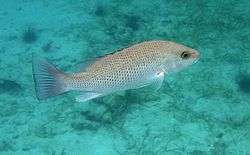Mangrove snapper
| Mangrove snapper | |
|---|---|
 | |
| Scientific classification | |
| Kingdom: | Animalia |
| Phylum: | Chordata |
| Class: | Actinopterygii |
| Order: | Perciformes |
| Family: | Lutjanidae |
| Genus: | Lutjanus |
| Species: | L. griseus |
| Binomial name | |
| Lutjanus griseus (Linnaeus, 1758) | |
 | |
| Synonyms | |
| |
The mangrove snapper or gray snapper (Lutjanus griseus) is a species of snapper native to the western Atlantic Ocean from Massachusetts to Brazil, the Gulf of Mexico, and the Caribbean Sea. They can be found in a wide variety of habitats, including brackish and fresh waters. It is commercially important, as well as being sought as a game fish. It can also be found in the aquarium trade.[2]
Description
Its color is typically greyish red, but it can change color from bright red to copper red. It has a dark stripe running across its eye if observed from the top when it is under water. This species can reach a length of 89 cm (35 in), though most do not exceed 40 cm (16 in). The greatest recorded weight for this species is 20 kg (44 lb).[2]
The mangrove snapper can be confused with the Cubera snapper or black snapper, Lutjanus cyanopterus. Mangrove snapper are typically much smaller than Cubera, but when they are of similar size, the two species can only be distinguished by examining the tooth patch on the inside roof of the mouth. Many specimens caught in Florida, specifically Punta Gorda, are actually misidentified dogtooth or dog snapper, Lutjanus jocu. The best way to distinguish between the two species is dog snapper has a lighter triangle of color with a blue band under the eye and large, sharp fangs in the front (canines), hence its common name. These fangs can deliver a painful bite, even in a small fish. The mangrove snapper feeds mostly on small fishes and crustaceans. It was also observed as systematically waiting under maternal colony of Buffy flower bat for falling bats near the entrances of Lucayan cavern, Bahamas.[3]
Habitat
The mangrove snapper is one of the most common species of snapper in warmer regions. It can be found in many areas from canals to grass flats, as well as in open water. Most mangrove snapper in the open water are generally found near bottom structure or reefs. They can be found at depths from 5 to 180 m (16 to 591 ft) though are mostly found at less than 50 m (160 ft).[2]
Sport fishing
Mangrove snapper is a common target for anglers, and is highly prized for its light and flaky flesh. It can be caught on a variety of baits, but is typically caught with live or frozen shrimp, squid, minnows and occasionally on artificial lures or baits. They can be spearfished, as well, but are sometimes a tough target, as they tend to be more wary of divers, rather than curious, and their wariness of baits and divers tends to increase as the fish grow larger. Most mangrove snapper are caught on light to medium tackle, and typical catches range from eight to 14 in long in shallow or in-shore waters, and up to 20 in long in deeper waters. Larger fish are uncommon, but not rare.
References
| Wikimedia Commons has media related to Lutjanus griseus. |
- ↑ Lindeman, K., Anderson, W., Carpenter, K.E., Claro, R., Cowan, J., Padovani-Ferreira, B., Rocha, L.A., Sedberry, G. & Zapp-Sluis, M. (2016). Lutjanus griseus. The IUCN Red List of Threatened Species doi:10.2305/IUCN.UK.2016-1.RLTS.T192941A2180367.en
- 1 2 3 Froese, Rainer and Pauly, Daniel, eds. (2013). "Lutjanus griseus" in FishBase. December 2013 version.
- ↑ Mikula, P. (2015). "Fish and amphibians as bat predators". European Journal of Ecology. 1 (1): 71–80. doi:10.1515/eje-2015-0010.
